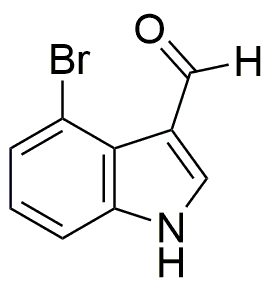4-Bromoindole-3-carboxaldehyde is widely utilized in research focused on:
- Synthesis of Pharmaceuticals: This compound serves as a key intermediate in the synthesis of various pharmaceuticals, particularly in the development of anti-cancer agents and neuroprotective drugs.
- Organic Electronics: It is used in the fabrication of organic light-emitting diodes (OLEDs) and organic solar cells, enhancing the efficiency and stability of these devices.
- Fluorescent Probes: Researchers employ it to create fluorescent probes for biological imaging, allowing for the visualization of cellular processes in real-time.
- Material Science: The compound is explored in the development of advanced materials, such as polymers and coatings, due to its unique electronic properties.
- Biochemical Research: It plays a role in studying enzyme interactions and metabolic pathways, providing insights into various biological processes.
General Information
Properties
Safety and Regulations
Applications
4-Bromoindole-3-carboxaldehyde is widely utilized in research focused on:
- Synthesis of Pharmaceuticals: This compound serves as a key intermediate in the synthesis of various pharmaceuticals, particularly in the development of anti-cancer agents and neuroprotective drugs.
- Organic Electronics: It is used in the fabrication of organic light-emitting diodes (OLEDs) and organic solar cells, enhancing the efficiency and stability of these devices.
- Fluorescent Probes: Researchers employ it to create fluorescent probes for biological imaging, allowing for the visualization of cellular processes in real-time.
- Material Science: The compound is explored in the development of advanced materials, such as polymers and coatings, due to its unique electronic properties.
- Biochemical Research: It plays a role in studying enzyme interactions and metabolic pathways, providing insights into various biological processes.
Documents
Safety Data Sheets (SDS)
The SDS provides comprehensive safety information on handling, storage, and disposal of the product.
Product Specification (PS)
The PS provides a comprehensive breakdown of the product’s properties, including chemical composition, physical state, purity, and storage requirements. It also details acceptable quality ranges and the product's intended applications.
Certificates of Analysis (COA)
Search for Certificates of Analysis (COA) by entering the products Lot Number. Lot and Batch Numbers can be found on a product’s label following the words ‘Lot’ or ‘Batch’.
*Catalog Number
*Lot Number
Certificates Of Origin (COO)
This COO confirms the country where the product was manufactured, and also details the materials and components used in it and whether it is derived from natural, synthetic, or other specific sources. This certificate may be required for customs, trade, and regulatory compliance.
*Catalog Number
*Lot Number
Safety Data Sheets (SDS)
The SDS provides comprehensive safety information on handling, storage, and disposal of the product.
DownloadProduct Specification (PS)
The PS provides a comprehensive breakdown of the product’s properties, including chemical composition, physical state, purity, and storage requirements. It also details acceptable quality ranges and the product's intended applications.
DownloadCertificates of Analysis (COA)
Search for Certificates of Analysis (COA) by entering the products Lot Number. Lot and Batch Numbers can be found on a product’s label following the words ‘Lot’ or ‘Batch’.
*Catalog Number
*Lot Number
Certificates Of Origin (COO)
This COO confirms the country where the product was manufactured, and also details the materials and components used in it and whether it is derived from natural, synthetic, or other specific sources. This certificate may be required for customs, trade, and regulatory compliance.


